Abstract
As a well-known ecological vulnerability region, monitoring and studying vegetation dynamics in southwestern China is important for resource management, ecological conservation, and climate adaptation strategies. The spatiotemporal dynamic characteristics of fractional vegetation cover (FVC) in southwestern China during the early 21st century was analyzed using MODIS Enhanced Vegetation Index (EVI) data. Additionally, this study employed the Geographic Detector Model (GDM), an innovative spatial statistical tool, to analyze the driving mechanism of FVC spatial patterns. The results indicated as follows: (1) the overall FVC in southwestern China exhibited a slight increasing trend, with distinct spatial heterogeneity; (2) the combined impacts of climate change and human activity could be the primary drivers of FVC changes, with relative contribution of 37.75% and 62.25%, respectively; (3) elevation was recognized as the key factor influencing this spatial variability, influencing hydrothermal conditions, vegetation types, soil types, and human activity intensity; (4) FVC increases steadily under high-emission scenarios of SSP370 and SSP585 from 2030 to 2100, while it exhibits an “increase–decrease” pattern under the low-emission scenarios of SSP126 and SSP245 from 2030 to 2100, with shifts occurring in 2080 and 2090, respectively. This pattern may result from the combined effects of moderate warming and fluctuations in precipitation, where initial hydrothermal conditions promote vegetation growth, but subsequent changes potentially inhibit it.
1. Introduction
Vegetation plays a crucial role in ecosystems by releasing oxygen and absorbing carbon dioxide through photosynthesis, thereby regulating atmospheric composition and mitigating climate change [1,2,3]. Moreover, vegetation cover protects soil, reduces erosion, enhances soil fertility, and supports water cycling by aiding groundwater recharge [4,5]. Fractional Vegetation Cover (FVC) is an essential indicator for assessing ecosystem health and biodiversity [6,7]. It directly regulates carbon sequestration and modulates hydrological cycles by reducing soil erosion rates. As a key input for SDG monitoring (notably Targets 15.3 and 13.1), it enables precise assessment of land degradation neutrality and vegetation resilience to climate extremes. Monitoring changes in FVC provides valuable insights into how ecosystems respond to both climate change and human activities, rendering it a central focus in ecological, environmental, and remote sensing research.
Traditional FVC measurement methods, such as visual estimation and point quadrat techniques, are labor-intensive and limited in spatial extent [8]. Over the past few years, remote sensing technologies have become the primary approach for large-scale FVC estimation [9,10]. These technologies have developed vegetation indices, including the NDVI and EVI, for efficient estimation of FVC over extensive areas [11,12,13]. Zhou et al. mapped FVC across the arid region of northwest China by Landsat NDVI data and analyzed the spatiotemporal variations and influencing factors [14]. Wang et al. assessed FVC dynamics across the Tibetan Plateau by MODIS EVI data, revealing the impact of topography on vegetation growth in various soil types [15]. Even the integration of multi-source remote sensing data (e.g., Landsat8 and Gaofen2) has been used to enhance spatial and temporal resolution and improve model accuracy [12]. Compared to NDVI, EVI provides enhanced robustness against atmospheric interference, improved sensitivity in high vegetation cover areas, a larger dynamic range for detecting changes, and a more balanced spectral response, making it a preferred choice for vegetation monitoring [16].
Climate change significantly impacts FVC through various mechanisms [17,18,19]. Rising temperatures can alter the timing and duration of growing seasons, affecting plant growth rates and ultimately leading to changes in FVC [14]. In addition, altered precipitation patterns, such as increased frequency of droughts or extreme rainfall, can impact soil moisture availability, further influencing vegetation health and coverage [20]. However, the role of human activities in shaping FVC is equally crucial [21,22]. Land use changes, such as agricultural expansion, deforestation, or urbanization, directly modify vegetation distribution and often result in decreased FVC [23]. Agricultural practices can either support or undermine vegetation cover depending on management techniques [21]. Except for climate change and human activities, other factors, such as biodiversity also influence FVC. However, since biodiversity is strongly influenced by both climate change and human activities, current research primarily focuses on the impacts of climate change and human activities on FVC [21,22]. In addition, current research on FVC predominantly focuses on historical trends, with comparatively less attention given to the standardized methodologies and responses of FVC to future climate change scenarios. Based on machine learning algorithms, FVC in China was predicted under four Shared Socioeconomic Pathways (SSPs, including SSP126, SSP245, SSP370, SSP585) from 2019 to 2060 [24]. Understanding how FVC responds to future climate change is essential for enhancing society’s capacity to adapt to climate impacts.
As a typical region significantly impacted by both climate change and human activities [25], studying FVC in southwestern China is particularly significant. This region is known for its diverse ecosystems and complex topography, which create a variety of microclimates that influence vegetation patterns. In addition, southwestern China, with its diverse vegetation spanning tropical to cold zones, is highly vulnerable to climate change, where specific climatic conditions exert pronounced impacts on FVC [26]. Understanding how FVC responds to climate variability and human activities in southwestern China provides critical insights into the intricate relationships between vegetation cover and environmental factors.
Therefore, based on MODIS EVI data, we investigated the spatiotemporal dynamic characteristics and driving mechanism of fractional vegetation cover (FVC) in southwestern China during the early 21st century from the Theil–Sen median, multiple regression residual analyses and the geographic detector model. Additionally, future FVC trends were projected by integrating climate scenario predictions with interaction analyses of driving mechanisms. The objectives of this study were ① to analyze the spatiotemporal dynamic characteristics of FVC in southwestern China; ② to determine the driving mechanism of FVC dynamics; ③ to project future FVC trends under various climate change scenarios. The findings in our study provide a comprehensive understanding of the evolutionary patterns of FVC, their driving mechanisms, and FVC trends in future in southwestern China.
2. Study Area
Comprising Sichuan, Chongqing, Yunnan, and Guizhou provinces, Southwestern China is a geographically significant region with a diverse and complex landscape. It is characterized by mountains, plateaus and basins, with the Hengduan Mountains in the northwest, the Sichuan Basin in the east and the Yun–Gui Plateau in the south (Figure 1). The climate in this region ranges from alpine climates in the north to subtropical monsoon climates in the south [27]. The Sichuan Basin and Yun–Gui Plateau experience warm, humid conditions with abundant rainfall, while the higher-altitude areas have cooler temperatures and less precipitation. This climatic variation, coupled with the monsoon’s influence, creates distinct wet and dry seasons, further shaping the region’s ecosystems.
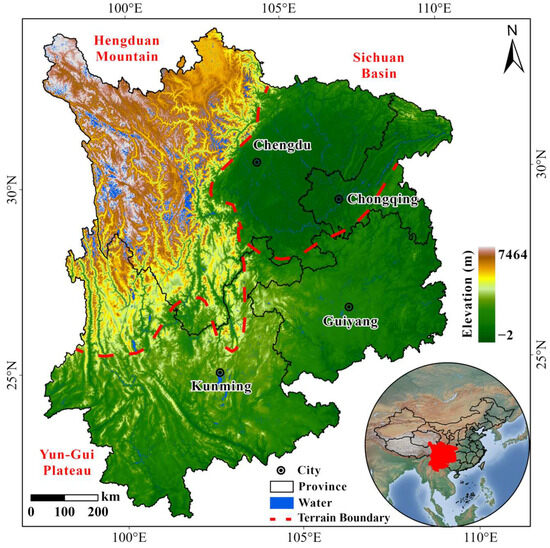
Figure 1.
The location and topography of southwestern China.
Southwestern China is a biodiversity hotspot, with ecosystems, including subtropical evergreen broadleaf forests, mountain coniferous forests, and alpine meadows, supporting a wide variety of plant and animal species [28]. However, the study area faces significant environmental challenges, such as land degradation, deforestation, and habitat fragmentation [29,30]. Human activities, including urbanization, agriculture, and mining, have accelerated development in this area, impacting its ecological balance. These activities have led to soil erosion, forest loss, and habitat destruction, increasing the region’s vulnerability to environmental degradation [31].
3. Data and Methods
3.1. Data Sources
The EVI data for southwestern China were acquired from the MOD13Q1 EVI dataset. The MOD13 product suite was developed to systematically monitor global vegetation dynamics through NDVI and EVI. MOD13 leverages MODIS’ 36 spectral bands (particularly Band 1–2 at 250 m and Band 3–7 at 500 m) with advanced atmospheric correction algorithms (6S Radiative Transfer Model) to mitigate aerosol and water vapor interference. Based on the method of maximum value compositing and resampling [32], an annual EVI dataset with 1 km resolution was generated from the MOD13Q1 data. This annual dataset was acquired from the Resource and Environmental Sciences Data Center (RESDC). To evaluate the accuracy of MOD13Q1 EVI data, we conducted a cross-validation with contemporaneous Landsat imagery (2013–2020) through the following protocol: (1) calculated Landsat EVI at 30 m resolution using Surface Reflectance Tier 1 products; (2) upscaled to 1 km resolution via bilinear aggregation with NDVI-guided spatial weighting; (3) performed rigorous QA filtering on both datasets (MODIS QA bits 0–3 = 00, Landsat cloud cover < 10%). The resultant comparison demonstrated strong consistency (R2 = 0.83 ± 0.05, RMSE = 0.07) across 85% of vegetated areas, confirming MOD13Q1’s reliability in capturing landscape-scale vegetation dynamics.
According to the terrain, southwestern China can be divided into the Hengduan Mountains, the Sichuan Basin, and the Yun–Gui Plateau. Topography (elevation, slope and aspect) and climate (temperature and precipitation) govern the hydrothermal conditions, determining the soil types and vegetation types, thereby influencing vegetation coverage in different regions. Moreover, human activities are a crucial factor affecting vegetation coverage, with indicators such as population density, Gross Domestic Product (GDP), and nighttime light serving as reflections of human presence and economic activity.
The climatic dataset was sourced from the 30′ Climatic Research Unit (CRU) dataset. Through delta spatial downscaling and validation with weather station observations, monthly air temperature and precipitation datasets across China were generated [33] and then aggregated into annual datasets (https://www.geodata.cn, accessed on 14 October 2024). The SRTM DEM, acquired from the Geospatial Data Cloud (GDC), was utilized in this study for both the elevation information and the extraction of slope and aspect. The soil and vegetation type, GDP and population density data were acquired from the RESDC. The Night-time light (NTL) dataset was obtained from the DMSP–OLS and NPP–VIIRS nighttime light data. Through a novel cross-sensor calibration, an NPP–VIIRS-like nighttime light dataset was created by combining DMSP–OLS data with monthly NPP-VIIRS data [34]. This dataset was acquired from the National Earth System Science Data Center (NESSDC) (Table 1). To align with the resolution of EVI data, SRTM DEM, Slope, Aspect and NTL datasets were upscaled to a 1 km resolution when investigating the driving mechanisms of FVC spatial patterns. This approach ensures consistency across datasets and enhances the accuracy of spatial analyses.

Table 1.
Main datasets used in FVC analysis in southwestern China.
The future climate scenarios dataset was derived from the Coupled Model Intercomparison Project Phase 6 (CMIP6) data. This dataset includes annual average temperature and precipitation projections under different scenarios, including SSP126, SSP245, SSP370, and SSP585. In addition, the accuracy of CMIP6 was improved by incorporating future CHELSA climate data (Climatologies at high resolution for the earth’s land surface areas). Although the CMIP6 dataset exhibits a comparatively coarse spatial resolution of 50 km, it is primarily used to provide a broader context for climate change at regional scale. Despite its limitations, CMIP6 data remains a valuable resource for understanding long-term climate trends and their potential impacts.
3.2. FVC Calculation
Based on the dimidiate pixel model, the FVC in southwestern China was calculated from EVI data. This method assumes that each pixel consists of a mixture of vegetation and bare soil [21]. By defining an EVI value for fully vegetated areas () and another for bare soil (), FVC can be estimated as
To account for regional variability in vegetation and soil reflectance, the 99th and 1st percentiles of pixel values within the study area were selected as adaptive thresholds for FVC calculation [21]. This approach enables reliable estimation of FVC over large regions using remotely sensed EVI data, which effectively reflects vegetation density and health. According to the distribution of vegetation in southwestern China [21,22,23], FVC was classified into five classes (Table 2).

Table 2.
Classification of FVC, FVC change and FVC fluctuation in southwestern China.
3.3. Theil–Sen Median Analysis and Mann–Kendall Test
The trend slope of FVC in this study was estimated by The Theil–Sen Median (TSM) analysis [35]. In TSM analysis, the slope is calculated as the median of all pairwise slopes between data points, making it especially useful for detecting monotonic trends in datasets with non-normal or skewed distributions. The Theil–Sen Median can be calculated as
where is the trend of FVC, and and represent different years. In addition, the significance of monotonic trends in this study was assessed by the Mann–Kendall (MK) test [36], then the trend of FVC was classified into four classes (Table 2).
3.4. Coefficient of Variation
The Coefficient of Variation (CV) was used to quantify the relative variability of data in relation to its mean [37]. The coefficient of variation can be calculated as
where is the length of the year, is the different year, and is the mean FVC. A lower CV suggests that the data values are more consistently clustered around the mean, whereas a higher CV indicates greater relative variability (Table 2).
3.5. Multiple Regression Residual Analysis
Multiple Regression Residual (MRR) analysis was used to identify unexplained variation in a dataset after accounting for the influence of several independent variables [38]. In MRR analysis, a dependent variable is modeled as a function of multiple predictors to quantify their combined effect. The residual represents the portion of the data that the model does not explain.
In general, FVC is influenced by a combination of climatic factors, human activities, and biodiversity. Notably, a significant linear relationship exists between vegetation coverage and climatic factors [21,22,23], while human activities and biodiversity affect its spatial distribution and dynamic changes through complex nonlinear mechanisms. In quantitative analyses, the linear impact of climatic factors can be isolated using multiple regression models, with the residual likely representing non-climatic factors (primarily anthropogenic activities). Given that biodiversity is strongly influenced by both climate change and human activities, this study focuses exclusively on the impacts of climate change and human activities on FVC. While this approach simplifies the analysis, it acknowledges the interconnected nature of biodiversity with these primary drivers. The multiple regression can be calculated as
where , and are the regression parameters, is the annual average temperature and is the annual total precipitation over the study period. and represent the predicted FVC and residual, attributed to the impacts of climate change and human activities, respectively. is the observed FVC from MODIS EVI [21,22,23]. The impacts of climate change and human activities on FVC change were categorized, and their relative contributions were calculated from observed FVC, and (Table 3).

Table 3.
Identification of effects and contributions of climate change and human activity on FVC.
3.6. Geographic Detector
The Geographic Detector was used to explore spatial heterogeneity and identify the driving forces behind spatially stratified phenomena [39]. The core principle of the Geographic Detector is to quantify the degree of spatial consistency between the dependent variable (e.g., vegetation cover, disease rates) and explanatory factors (e.g., climate, land use, socioeconomic factors). The tool divides a study area into subregions based on the explanatory variables and then compares the spatial distributions of the dependent and independent variables. The main output is a “q-statistic” that indicates how strongly each factor explains the observed spatial variance [39].
Based on previous studies and the regional characteristics of southwestern China [14,21,23,40], ten factors were selected to assess their influences on FVC in the study area (Table 1). Given the substantial diversity within the southwestern region, variables categorized by gradient are classified using the maximum number of classifications, while variables with specific physical and chemical properties are classified according to a primary classification standard. Using the natural breakpoint method, the temperature and precipitation, SRTM DEM, slope and aspect were categorized into nine classes. According to the 1:1,000,000 thematic map classification, vegetation types were categorized into six classes: coniferous forest, broadleaf forest, shrubland, herbaceous vegetation, meadow and cultivated vegetation. Soil type were categorized into six classes: leached soil, protogenic soil, anthrosol, alpine soil, ferralitic soil and urban rock. The q value of each factor can be calculated as
where ranged from 0 to 1, = 1, 2, …, is the stratification of the independent factor, and are the unit count, and and are the variance of FVC. and represent the within-layer variance and the total variance for the whole region, respectively.
Each factor’s independent impact on spatial variation can be assessed using individual q-statistics. The interplay among various factors is intricate; for instance, topography influences climate, and together they shape vegetation types, soil types, and human activities. Therefore, the interaction detector goes further by evaluating whether the combined influence of two factors is less than, equal to, or greater than the sum of their separate effects.
The methodological flowchart is shown in Figure 2.
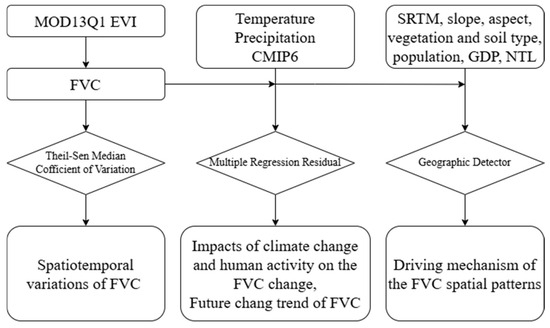
Figure 2.
The workflow used for the analysis of FVC change.
4. Results
4.1. FVC Spatial Patterns
Overall, southwestern China exhibited a medium–high level of vegetation cover, with a mean FVC of 0.53 observed in the early 21st century. The FVC varied little across provinces, with Guizhou having the highest FVC at 0.57, while Sichuan had the lowest at only 0.49.
Significant spatial heterogeneity in FVC had been observed across southwestern China, exhibiting an overall distribution pattern of high to low FVC from southeast to northwest (Figure 3). The medium–high FVC and medium FVC predominantly covered the entire study area, representing 45.98% and 30.19% of the total area of southwestern China. The medium–high FVC was primarily located in the Yun–Gui Plateau, while the medium FVC was centered in the Sichuan Basin and northern Yunnan Province. The high FVC, representing 15.6% of southwestern China, was located in southern Yunnan Province and around the Sichuan Basin. The medium-low FVC and low FVC had the smallest distribution, representing only 8.23% of southwestern China, mainly centered in the Hengduan Mountains.
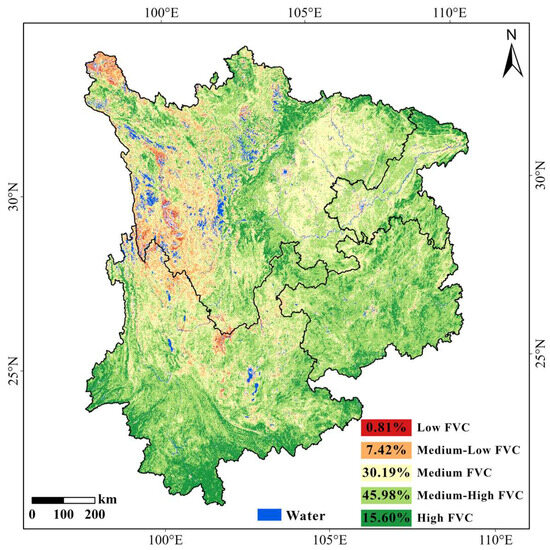
Figure 3.
The distribution of mean FVC in southwestern China; different colors represent distinct classifications, while the numbers indicate the proportion of the area that each classification occupies within the entire study region.
4.2. FVC Temporal Dynamics
Compared to the classification of FVC in 2000, the area covered by high FVC in 2022 had significantly increased, rising from 17.89% to 25.67%. Conversely, the area covered by medium FVC had significantly decreased, from 33.16% to 27.12%. The area proportions of the other three FVC classes—medium–high, medium-low and low FVC—showed only slight fluctuations (Figure 4).
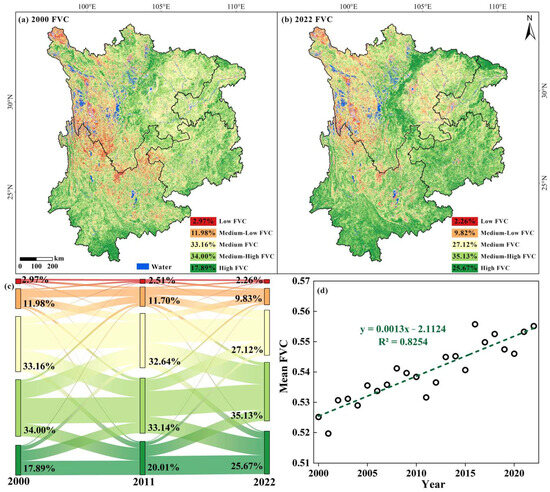
Figure 4.
Dynamic changes in FVC in southwestern China in the early 21st century. (a,b) The distribution of FVC in 2000 and 2022. (c) The transfer matrix of different FVC classifications, different colors represent distinct classifications. (d) The trend of FVC in the early 21st century.
Complex transitions between different FVC classes were observed during various time periods in southwestern China (Figure 4c). Overall, more than 50% of total area experienced changes in FVC during the two sub-periods. The most intense transitions occurred between the medium and medium–high FVC classes from 2000 to 2011, covering over 200,000 km2 and contributing more than 35% of the total transitions. The transitions between the medium and medium–high FVC were roughly balanced, while the area shifting from the medium–high FVC to high FVC exceeded the area shifting from the high FVC to medium–high FVC. This resulted in an increase and a decrease in high FVC and medium–high FVC from 2000 to 2011, respectively. During 2011–2022, the most intense transitions occurred from medium–high to high FVC and from the medium to medium–high FVC. These transitions resulted in a notable decrease in medium FVC, along with increases in medium–high and high FVC from 2011 to 2022. Overall, the medium FVC decreased and the high FVC increased rapidly, resulting in an overall increasing trend in FVC.
The annual mean FVC varied between 0.50 to 0.55 in southwestern China in the early 21st century, with the lowest FVC of 0.5001 in 2001 and the highest FVC of 0.5458 in 2022. Based on linear regression analysis on the annual mean FVC, the FVC showed a slight increase at a rate of 1.6 × 10−3 a−1 (with confidential level < 0.05) (Figure 4d).
4.3. Change Trend for FVC and Its Stability
4.3.1. FVC Change Trend
According to the TSM analysis and the MK test, slight FVC improvement and slight FVC degradation predominantly covered southwestern China, representing 45.39% and 30.59%, respectively. Slight FVC improvement was primarily located in the east, while slight FVC degradation was centered in the west. In addition, the area of significant FVC improvement exceeded that of significant FVC degradation, accounting for 18.6% and 5.40%, respectively. Significant FVC improvement primarily occurred around the Sichuan Basin, whereas significant FVC degradation was observed within the Sichuan Basin. Overall, the area of FVC improvement was greater than FVC degradation, exhibiting a significant spatial heterogeneity in FVC change trends across southwestern China (Figure 5).
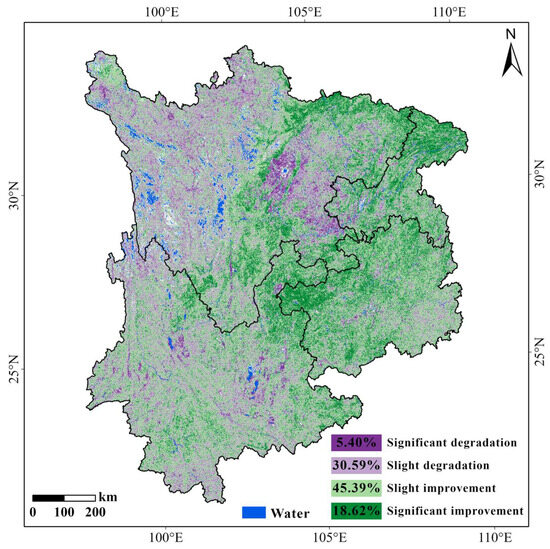
Figure 5.
Change trend for FVC in southwestern China in the early 21st century.
4.3.2. FVC Stability
Based on the calculation of coefficient of variation in FVC, relatively low fluctuation and moderate fluctuation predominantly covered southwestern China, accounting for 47.01% and 35.15%, respectively. These fluctuations were centered in the Sichuan Basin and the Yun–Gui Plateau. Relatively high and high fluctuations, representing 15.54% of the total area, were found in the Hengduan Mountains. Low fluctuation had the smallest distribution, accounting for only 2.30%, and was scattered across the region. Notably, the four provincial capitals—Chengdu, Chongqing, Guiyang and Kunming—exhibited relatively high or high fluctuations in FVC during the early 21st century (Figure 6).
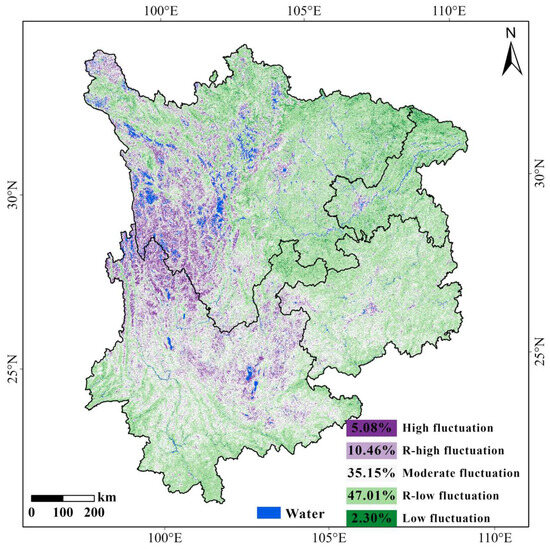
Figure 6.
Coefficient of variation of FVC in southwestern China in the early 21st century.
4.4. Impacts of Climate Change and Human Activity on FVC Change
4.4.1. FVC Change Trends Under the Impacts of Climate Changes and Human Activities
Based on MRR analysis, TMS analysis and the MK test, 62.16% of the total area of southwestern China exhibited an increasing trend in FVC, with 25.73% showing significant improvement, under the effect of climate change. These regions were centered in Guizhou Province and around the Sichuan Basin. Conversely, 37.84% of the total area of southwestern China exhibited a decreasing trend in FVC, including 12.22% experiencing significant degradation within the Sichuan Basin and 25.62% undergoing slight degradation in the Hengduan Mountains and Yunnan Province (Figure 7a).
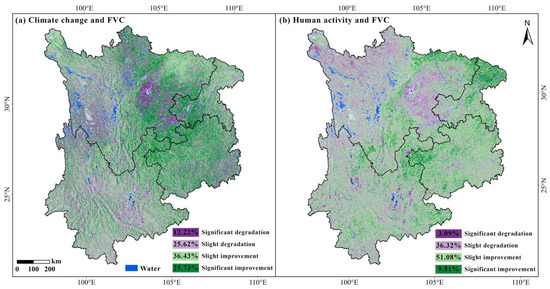
Figure 7.
The trends in FVC change under the impacts of climate changes and human activities.
Under the effect of human activities, 60.59% and 39.41% of the total area of southwestern China experienced an increasing and a decreasing trend in FVC, respectively. FVC improvement primarily occurred in Guizhou Province and around the Sichuan Basin, whereas FVC degradation was centered in the Hengduan Mountains, Yunnan Province and within the Sichuan Basin. Notably, only 9.51% and 3.09% of the total area of southwestern China exhibited significant improvement and degradation in FVC, respectively (Figure 7b).
Overall, similar proportions and spatial distribution of FVC improvement/degradation were observed under the impacts of climate change and human activities. However, climate change had a significant impact on driving both significant improvement and significant degradation in FVC, while human activities primarily induced slight improvement and slight degradation in FVC.
4.4.2. Driving Effects of Climate Change and Human Activities on FVC Changes
To further investigate the driving effects of climate change and human activities on FVC changes, the trends of FVCcc and FVCha change were analyzed in combination (Figure 8). The TSM analysis showed that 35.99% of the total area of southwestern China experienced FVC degradation. Among the FVC degradation, 19.09% was attributed to the joint impact, centered within the Sichuan Basin. The remaining 5.20% and 11.70% of FVC degradation were attributed solely to climate changes and human activities, respectively. Conversely, 64.01% of the total area exhibited FVC improvement. Among these, 41.92% was attributed to the joint impact, primarily located in Guizhou Province and around the Sichuan Basin. In addition, 8.63% and 13.46% of FVC improvement were attributed solely to climate changes and human activities, respectively. Overall, the joint impact played a significant role in FVC changes across southwestern China in the early 21st century.

Figure 8.
Driving effects of climate changes and human activities on FVC changes.
4.4.3. Contributions of Climate Change and Human Activities to FVC Changes
The trends in FVCcc and FVCha change were compared with the trend in FVC change to quantify the contributions of climate changes and human activities to FVC changes. Overall, the contribution of climate change and human activities to FVC changes were 37.75% and 62.25%, respectively.
For the contribution of climate change, areas with a contribution of less than 20% represented 42.41% of southwestern China, centered in Yunnan Province, the Hengduan Mountains and the northeastern Sichuan Basin. Within these areas, 25.16% was solely attributed to the effect of human activity, including 13.46% driven by human promotion and 11.70% by human inhibition. In contrast, areas with a contribution exceeding 80% covered 19.91% of southwestern China, centered within the Sichuan Basin. Of these, 13.83% was solely attributed to the effect of climate change, including 8.63% driven by climate promotion and 5.20% by climate inhibition. Excluding areas affected solely by climate changes or human activities, areas where climate changes contributed less than 60% represented 47.69% of the total area of southwestern China, while areas with climate changes contributions exceeding 60% covered 13.32% (Figure 9a).
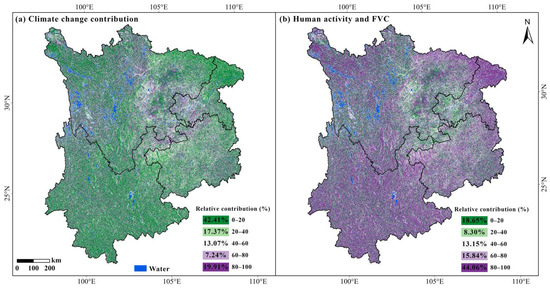
Figure 9.
Contribution of (a) climate change and (b) human activity.
For the contribution of human activities, areas with contributions of less than 20% and more than 80% represented 18.65% and 44.06% of the total area of southwestern China, respectively. In addition, 13.83% and 25.16% of southwestern China were solely impacted by climate change and human activities, respectively. Excluding areas solely affected by climate changes or human activities, areas where human activity contributed less than 40% represented 13.13% of southwestern China, while areas with human activities contributions exceeding 40% represented 47.88% (Figure 9b).
4.5. Driving Mechanism of FVC Spatial Patterns
4.5.1. Single Factor Detection
A systematic selection of ten natural and human activity factors, encompassing climatic variables (temperature, precipitation), terrain attributes (elevation, slope, aspect), vegetation type and soil type, and human activity indicators (GDP, population density, NTL), was subjected to Geographical Detector (GD) modeling. According to the result of Geographic Detector analysis, the explanatory power of various factors on the FVC spatial pattern was ranked as follow: Elevation > Population density > GDP > Soil type > Night Time Light > Precipitation > Temperature > Slope > Vegetation type > Aspect (Figure 10a).
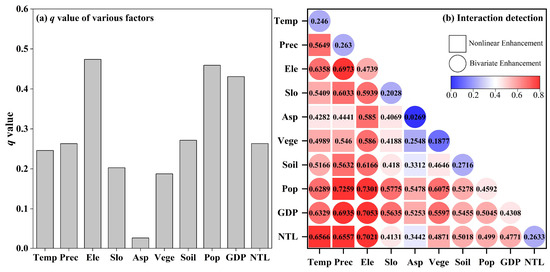
Figure 10.
The explanatory powers of various factors and interaction detection in southwestern China.
Elevation, population density and GDP emerged as the primary factors influencing the FVC spatial pattern across southwestern China, with explanatory powers of 47.86%, 45.92% and 43.08%, respectively. Secondary major influencing factors include soil type (27.16%), night-time light (26.33%), precipitation (26.30%), temperature (24.60%), and slope (20.28%). Vegetation type, with an explanatory power of 18.77%, plays a minor role, while aspect has a negligible explanatory power of only 2.69% regarding the FVC spatial pattern across southwestern China.
4.5.2. Interaction Detection
To explore the interactions between various factors on the FVC spatial pattern, the interaction detector was employed in this study. Two types of interactions—bivariate and nonlinear enhancement—were identified between various factors. This finding suggests that the factors influencing the FVC spatial pattern in southwestern China were not independent but rather interrelated, with their combined effects amplifying the overall explanatory power (Figure 10b).
The interaction between elevation and other factors had the greatest explanatory power, which explained over 60% of the FVC spatial pattern. Among these, the interaction between elevation and human activity factors demonstrated the greatest explanatory power, reaching approximately 70%. Interactions involving population density, GDP, NTL, temperature, precipitation, and other factors consistently ranked among the top two to six combinations, with explanatory powers exceeding 50%. In contrast, the interaction between aspect and other factors had relatively lower explanatory power, consistently ranking the lowest among the various interaction results. These results further corroborate the findings from the factor detector analysis, highlighting that elevation, population density and GDP exerted greater influences on FVC spatial heterogeneity across southwestern China compared to aspect and vegetation type.
4.6. Future Change Trend in FVC
Assuming that the intensity and scope of past human activities will remain unchanged in the future, future vegetation dynamics were then calculated using climate data from various Shared Socioeconomic Pathways [24]. A multiple linear regression model was developed based on the relationship between historical FVC, temperature, and precipitation. This model, combined with future climate scenario data, was subsequently used to predict FVC trends in southwestern China under various climate projections.
Initialized with modern observational datasets (ERA5-land), future climate change projections indicate an increasing trend in temperature across all various scenarios. The rates of temperature increase are 0.11, 0.36, 0.64, and 0.94 °C/decade, respectively (Figure 11a). In contrast, precipitation exhibits more complex fluctuations under the different scenarios. Precipitation is projected to increase under the SSP126 and SSP245 scenarios, with 14.0 and 12.6 mm/decade, respectively. However, under the SSP370 and SSP585 scenarios, precipitation is expected to decrease, with −2.0 and −8.7 mm/decade, respectively (Figure 11b). These divergent trends underscore the varying effects of different climate change pathways on hydrothermal conditions across southwestern China.
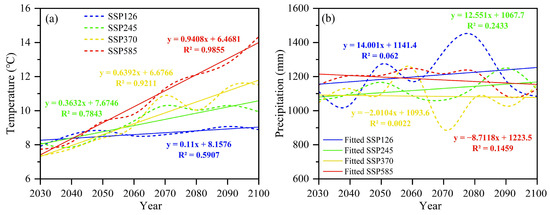
Figure 11.
The tendencies of temperature and precipitation across southwestern China in the future. (a) The tendencies of temperature under the different scenarios. (b) The tendencies of precipitation under the different scenarios.
According to the multiple linear regression model, the future dynamics of FVC exhibit distinct trends under various SSP scenarios across southwestern China (Figure 12). Under the SSP370 and SSP585 scenarios, FVC shows a consistent increasing trend, likely driven by the stronger warming effects, that may facilitate growing season prolongation and nutrient cycling acceleration. Conversely, under the SSP126 and SSP245 scenarios, FVC exhibits an “increase–decrease” pattern, with the shift in trend occurring in 2080 and 2090, respectively. This pattern may result from the combined effects of moderate warming and fluctuations in precipitation, where initial hydrothermal conditions promote vegetation growth, but subsequent changes potentially inhibit it [41,42]. Notably, FVC exhibits an “increase–decrease” pattern in the low emission scenario, suggesting that human activities designed to adapt to current climate conditions may prove effective in the short term but may not remain beneficial in the long term. FVC dynamics in the future underscore the need for adaptive and forward-looking management strategies that account for potential shifts in climate conditions. Proactive planning and flexibility in land-use practices and ecological restoration efforts will be critical to sustaining vegetation growth and ecosystem services in the long term.
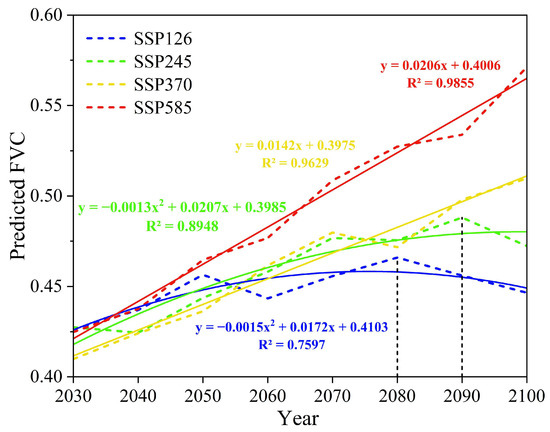
Figure 12.
The trend in FVC in southwestern China in the future under four scenarios.
Furthermore, the future dynamics of FVC in southwestern China exhibit pronounced spatial heterogeneity under various SSP scenarios. Under the SSP126 and SSP245 scenarios, FVC shows a faster increasing trend in the Yun–Gui Plateau compared to the Hengduan Mountains and the Sichuan Basin. In contrast, under the SSP370 and SSP585 scenarios, the FVC increasing trend becomes more pronounced in the Hengduan Mountains and the Sichuan Basin, respectively. Under different climate scenarios, all regions show a consistent trend of increasing temperatures; however, significant spatial heterogeneity is observed in precipitation patterns. In the Hengduan Mountains, precipitation is projected to slightly increase under various SSP scenarios. The Sichuan Basin is expected to experience a slight decrease in precipitation under the SSP126, SSP245 and SSP370 scenarios, but a significant decrease under the SSP585 scenario. In contrast, the Yun–Gui Plateau is projected to see a significant increase in precipitation under the SSP126 and SSP245 scenarios, while a significant decrease is anticipated under the SSP370 and SSP585 scenarios. Apparently, the faster increasing trend of FVC in the Yun–Gui Plateau under SSP126 and SSP245 is likely to have been driven by the significant increase in precipitation. The pronounced increasing trend of FVC in the Hengduan Mountains under the SSP 370 results from the combined effects of rising temperatures and increased precipitation. Despite a significant decrease in precipitation, the FVC in the Sichuan Basin still exhibits a pronounced increasing trend under the SSP585, primarily driven by the substantial rise in temperatures. It is evident that the future dynamics of Fractional Vegetation Cover (FVC) in the Hengduan Mountains will be jointly influenced by temperature and precipitation, reflecting the region’s complex topography and climate interactions. In contrast, the Sichuan Basin will be predominantly driven by temperature, likely due to its relatively stable precipitation patterns, while the Yunnan–Guizhou Plateau will be significantly shaped by precipitation, highlighting its sensitivity to changes in water availability.
5. Discussion
5.1. The Spatiotemporal Variations of FVC
Remote sensing evidence derived from multiple data sources and indicators demonstrates that the greening of vegetation, which began in the 1980s, has persisted to the present day. This trend is particularly pronounced in the high-latitude regions of the Northern Hemisphere, as well as in agricultural lands and afforestation areas [18,19]. According to MODIS data, one-third of the global vegetated area is greening, and the direct factor (human land-use management) is a key driver of “Greening Earth”, accounting for over a third of the observed net increase in green leaf area [17]. As a typical region significantly impacted by both climate change and human activities, southwestern China exhibited a slight increasing trend in FVC during the early 21st century, with over 64% of the area showing FVC improvement.
Many researchers have explored the variations of FVC in southwestern China and their responses to climate changes and human activities [23,26,43,44,45]. Generally, better hydrothermal conditions promote vegetation growth and result in higher FVC. Based on the CRU dataset, the annual average temperature and total precipitation in southwestern China were 12.5 °C and 1014 mm, respectively. These conditions contributed to a medium–high level of FVC across southwestern China in the early 21st century. In addition, the wide range of annual average temperatures (−9.4 °C to 24.4 °C) and total precipitation (489 mm to 2011 mm) across the region had a significant impact on the significant spatial heterogeneity of FVC. Furthermore, an increasing trend of +0.2 °C/decade in the annual average temperature had been found from 2000 to 2022. ERA5-land reanalysis datasets reveal a statistically significant warming trend across Southwest China since 2000, manifested by two key characteristics: intensification of extreme heat events and increase in annual warm days. The significant increase in temperature resulted in the extension of plant growth season, and the decomposition and release of soil nutrients and organic matter, thereby significantly promoting the growth of vegetation [46]. Meanwhile, a decreasing trend of −25 mm/decade in the annual total precipitation was observed, leading to reduced soil moisture and increased vegetation water consumption, which inhibited vegetation growth [23]. Additionally, if the trends continue, evapotranspiration is likely to increase, which may lead to plant stress and succession on some spatial/temporal scale. However, the FVC in southwestern China exhibited a slight increasing trend, suggesting that the promoting effect of increased temperature surpassed the inhibiting effect of reduced precipitation. Previous researches have highlighted that temperature was the primary climatic factor controlling FVC changes across southwestern China [23,43].
In addition, human activities had a significant impact on FVC changes across southwestern China in the early 21st century [23,47]. The relative contribution of human activities to FVC changes was 62.25%, exceeding the 37.75% contribution from climate change. Human activities, such as indiscriminate logging and overgrazing, resulted in the decreasing of forests and grasslands, resulting in FVC decline [29]. Furthermore, urbanization processes converted croplands, grasslands, and forests into construction land, inhibiting vegetation growth [48]. This pattern was particularly evident in economically developed regions, especially in capital cities. However, the implementation of forestry and ecological restoration projects increased FVC significantly [49]. Land use changes further supported this trend, with a substantial reduction in farmland, which was mainly converted into forestland, grassland, and developed land [47]. Overall, 60.59% of southwestern China experienced an increasing trend in FVC due to human activity, indicating that the promoting effects of these activities outweighed their inhibiting impacts.
5.2. Driving Mechanism of FVC Spatial Patterns
Distinct spatial heterogeneity in FVC was observed across southwestern China, with elevation identified as the primary factor driving this variation [23,50]. The complex terrain, characterized by spatial heterogeneity in elevation, influenced the spatial variability of hydrothermal conditions (temperature and precipitation), subsequently affecting vegetation and soil types, as well as the intensity and scope of human activities. Therefore, elevation exhibits the greatest explanatory power for FVC spatial patterns across southwestern China.
Moreover, the factors influencing the spatial heterogeneity of FVC were not independent but rather interrelated, with their combined effects amplifying the overall explanatory power [21,23]. As discussed earlier, elevation significantly influences both natural and anthropogenic factors in southwestern China, making the interaction between elevation and other factors the primary driver of FVC variability. In addition, interactions among population density, GDP, night-time light, temperature, and precipitation also exhibited high explanatory power, further highlighting the complexity of factors shaping FVC patterns. However, not all paired factors in their interactions exhibited uniformly positive or negative effects on FVC variability. In some cases, the interaction between two factors could enhance or offset each other’s influence, leading to complex and region-specific impacts on FVC [51].
It is noteworthy that the spatial distribution and variation of FVC exhibit a relatively consistent spatial heterogeneity. The FVC within the Sichuan Basin and at Hengduan Mountain is relatively low, showing a significant trend of degradation in the early 21st century. The Sichuan Basin and Hengduan Mountain represent the lowest and highest altitude regions in the southwestern China, yet they exhibit a similar spatial pattern in FVC. This indicates that, apart from elevation, other factors play a significant role in shaping the characteristics of FVC in these two areas. The Sichuan Basin has experienced stable temperatures but a significant increase in precipitation [33], which may contribute to an improvement in FVC. However, significant FVC degradation was observed within the Sichuan Basin, suggesting that the adverse effects of human activities far outweigh the positive impacts of climate changes on FVC. As a region characterized by intense human activity, the Sichuan Basin has experienced substantial land use changes, including a more than 50% increase in built-up land, alongside significant growth in population density, GDP, and nighttime light intensity [23,34]. In the Hengduan Mountains, temperatures have exhibited minor fluctuations [33], while a significant decline in precipitation has resulted in a gradual degradation of FVC. Additionally, driven by socio-economic development, human activities have progressively expanded from lower altitudes to higher altitudes, primarily for cultivation and grazing, further intensifying the degradation of FVC [23,52].
5.3. Limitations and Future Work
This study acknowledges several uncertainties in understanding the spatiotemporal variations and future temporal dynamics of FVC and its driving mechanisms. Firstly, the spatial and temporal resolution of EVI data imposes constraints on conducting more detailed analyses of FVC changes, particularly in regions with complex topography or rapid land use transitions, highlighting the need for higher-resolution datasets in future research. Secondly, the models used to analyze the drivers of FVC changes, based on climate change and human activities, require significant improvements in both the elements they incorporate (e.g., land use dynamics) and their precision, to better capture the complex interactions shaping vegetation dynamics. Secondly, the current analysis of the effect of climate change on FVC employs a simplified model using zero-lag interannual averages; future studies could incorporate lagged variables or adopt nonlinear models to better capture the temporal dynamics of FVC responses to climatic variations. Additionally, the climatic parameters used in our study to project future FVC trends are decadal time scales, which may obscure detailed information about annual vegetation changes, suggesting the need for finer temporal resolution in future analyses. Lastly, the distinct effects of climate change, human activity, and natural disturbances (such as typhoons and landslides) on FVC have not been fully disentangled, necessitating further research to clarify their individual and combined impacts, particularly through integrated modeling approaches and long-term observational data. Despite these limitations, the findings of this study provide a scientific foundation for making informed choices regarding future vegetation management, thereby supporting the development of robust and sustainable plant ecosystems.
6. Conclusions
This study analyzes the spatiotemporal variations of FVC and its driving mechanism across southwestern China in the early 21st century.
- (1)
- The overall FVC in southwestern China exhibited a slight increasing trend, with distinct spatial heterogeneity. Elevation was identified as the primary factor driving this spatial variability, influencing hydrothermal conditions, vegetation types, soil types, and human activity intensity. The factors influencing FVC were not independent but interrelated, with interactions amplifying their combined explanatory power. The interaction between elevation and other factors had the greatest explanatory power on FVC spatial pattern.
- (2)
- The joint impact of climate changes and human activities were the primary drivers of FVC changes. The relative contribution of human activity (62.25%) outweighed that of climate change (37.75%). Activities such as indiscriminate logging and urbanization inhibited FVC, while ecological restoration projects significantly promoted it.
- (3)
- Based on various SPP scenarios, future FVC predictions show varying trends. Under high-emission scenarios, FVC increases steadily while, under low-emission scenarios, it exhibits an “increase-decrease” pattern, with shifts occurring in 2080 and 2090 under SSP126 and SSP245, respectively. FVC dynamics in the future underscore the need for adaptive and forward-looking management strategies that account for potential shifts in climate conditions.
- (4)
- Further research on FVC need to clarify the individual and combined impacts of climate change and human activities, particularly through integrated modeling approaches and long-term observational data. This includes the application of dynamic land-use models, higher-resolution remote sensing datasets, and spatially explicit analyses to better understand the mechanisms driving vegetation dynamics under varying environmental and anthropogenic pressures.
Author Contributions
Conceptualization, P.C., K.W., Y.P.; methodology, P.C., K.W; software, P.C.; validation, K.W.; formal analysis, P.C.; data curation, K.W.; writing—original draft preparation, P.C., K.W.; writing—review and editing, P.C., K.W., Y.P.; visualization, P.C., K.W.; supervision, Y.P.; project administration, K.W.; funding acquisition, K.W. All authors have read and agreed to the published version of the manuscript.
Funding
This research was funded by the National Natural Science Foundation of China, NSFC (grant nos. 42361021; 41971169), the Natural Science Foundation of Yunnan (grant nos. 202401AS070125; 202301AT070417), a grant for talent introduction of Yunnan University.
Data Availability Statement
The raw data supporting the conclusions of this article will be made available by the authors on request.
Acknowledgments
The authors thank the following institutions for providing materials for this study: the Resource and Environmental Sciences Data Center (RESDC) for EVI, vegetation types, soil types, population and GDP dataset, the National Earth System Science Data Center (NESSDC) for the temperature, precipitation and NTL dataset, and the Geospatial Data Cloud (GDC) for the SRTM DEM.
Conflicts of Interest
The authors declare no conflicts of interest.
References
- Bonan, G.B. Forests and Climate Change: Forcings, Feedbacks, and the Climate Benefits of Forests. Science 2008, 320, 1444–1449. [Google Scholar] [CrossRef] [PubMed]
- Li, D.; Pan, M.; Cong, Z.; Zhang, L.; Wood, E. Vegetation control on water and energy balance within the Budyko framework. Water Resour. Res. 2013, 49, 969–976. [Google Scholar] [CrossRef]
- Loisel, J.; Yu, Z. Surface vegetation patterning controls carbon accumulation in peatlands. Geophys. Res. Lett. 2013, 40, 5508–5513. [Google Scholar] [CrossRef]
- Kim, J.H.; Jackson, R.B. A Global Analysis of Groundwater Recharge for Vegetation, Climate, and Soils. Vadose Zone J. 2012, 11. [Google Scholar] [CrossRef]
- Shao, J.; Si, B.; Jin, J. Rooting Depth and Extreme Precipitation Regulate Groundwater Recharge in the Thick Unsaturated Zone: A Case Study. Water 2019, 11, 1232. [Google Scholar] [CrossRef]
- Carlson, T.N.; Ripley, D.A.J. On the relation between NDVI, fractional vegetation cover, and leaf area index. Remote Sens. Environ. 1997, 62, 241–252. [Google Scholar] [CrossRef]
- Hill, M.J.; Guerschman, J.P. Global trends in vegetation fractional cover: Hotspots for change in bare soil and non-photosynthetic vegetation. Agric. Ecosyst. Environ. 2022, 324, 107719. [Google Scholar] [CrossRef]
- De Stefano, A.; Fowers, B.; Mealor, B.A. Comparison of visual estimation and line-point intercept vegetation survey methods on annual grass–invaded rangelands of Wyoming. Invasive Plant Sci. Manag. 2021, 14, 240–252. [Google Scholar] [CrossRef]
- Gao, L.; Wang, X.; Johnson, B.A.; Tian, Q.; Wang, Y.; Verrelst, J.; Mu, X.; Gu, X. Remote sensing algorithms for estimation of fractional vegetation cover using pure vegetation index values: A review. ISPRS J. Photogramm. Remote Sens. 2020, 159, 364–377. [Google Scholar] [CrossRef]
- Zhu, Z.; Woodcock, C.E. Continuous change detection and classification of land cover using all available Landsat data. Remote Sens. Environ. 2014, 144, 152–171. [Google Scholar] [CrossRef]
- Ghazal, M.; Khalil, Y.A.; Hajjdiab, H. UAV-based remote sensing for vegetation cover estimation using NDVI imagery and level sets method. In Proceedings of the 2015 IEEE International Symposium on Signal Processing and Information Technology (ISSPIT), Abu Dhabi, United Arab Emirates, 7–10 December 2015; pp. 332–337. [Google Scholar]
- Song, D.; Wang, Z.; He, T.; Wang, H.; Liang, S. Estimation and validation of 30 m fractional vegetation cover over China through integrated use of Landsat 8 and Gaofen 2 data. Sci. Remote Sens. 2022, 6, 100058. [Google Scholar] [CrossRef]
- Zhao, T.; Mu, X.; Song, W.; Liu, Y.; Xie, Y.; Zhong, B.; Xie, D.; Jiang, L.; Yan, G. Mapping Spatially Seamless Fractional Vegetation Cover over China at a 30-m Resolution and Semimonthly Intervals in 2010–2020 Based on Google Earth Engine. J. Remote Sens. 2023, 3, 0101. [Google Scholar] [CrossRef]
- Zhou, Q.; Chen, W.; Wang, H.; Wang, D. Spatiotemporal evolution and driving factors analysis of fractional vegetation coverage in the arid region of northwest China. Sci. Total Environ. 2024, 954, 176271. [Google Scholar] [CrossRef]
- Wang, R.; Wang, Y.; Yan, F. Vegetation Growth Status and Topographic Effects in Frozen Soil Regions on the Qinghai–Tibet Plateau. Remote Sens. 2022, 14, 4830. [Google Scholar] [CrossRef]
- Son, N.T.; Chen, C.F.; Chen, C.R.; Minh, V.Q.; Trung, N.H. A comparative analysis of multitemporal MODIS EVI and NDVI data for large-scale rice yield estimation. Agric. For. Meteorol. 2014, 197, 52–64. [Google Scholar] [CrossRef]
- Chen, C.; Park, T.; Wang, X.; Piao, S.; Xu, B.; Chaturvedi, R.K.; Fuchs, R.; Brovkin, V.; Ciais, P.; Fensholt, R.; et al. China and India lead in greening of the world through land-use management. Nat. Sustain. 2019, 2, 122–129. [Google Scholar] [CrossRef]
- Piao, S.; Wang, X.; Park, T.; Chen, C.; Lian, X.; He, Y.; Bjerke, J.W.; Chen, A.; Ciais, P.; Tømmervik, H.; et al. Characteristics, drivers and feedbacks of global greening. Nat. Rev. Earth Environ. 2019, 1, 14–27. [Google Scholar] [CrossRef]
- Zhu, Z.; Piao, S.; Myneni, R.B.; Huang, M.; Zeng, Z.; Canadell, J.G.; Ciais, P.; Sitch, S.; Friedlingstein, P.; Arneth, A.; et al. Greening of the Earth and its drivers. Nat. Clim. Change 2016, 6, 791–795. [Google Scholar] [CrossRef]
- Mao, L.; Pei, X.; He, C.; Bian, P.; Song, D.; Fang, M.; Wu, W.; Zhan, H.; Zhou, W.; Tian, G. Spatiotemporal Changes in Vegetation Cover and Soil Moisture in the Lower Reaches of the Heihe River Under Climate Change. Forests 2024, 15, 1921. [Google Scholar] [CrossRef]
- Tian, X.; Tao, Z.; Xie, Y.; Shao, W.; Zhang, S. Spatiotemporal Evolution and Driving Mechanism of Fractional Vegetation Coverage in the Yangtze River Delta. IEEE J. Sel. Top. Appl. Earth Obs. Remote Sens. 2024, 17, 10979–10997. [Google Scholar] [CrossRef]
- Tong, S.; Zhang, J.; Ha, S.; Lai, Q.; Ma, Q. Dynamics of Fractional Vegetation Coverage and Its Relationship with Climate and Human Activities in Inner Mongolia, China. Remote Sens. 2016, 8, 776. [Google Scholar] [CrossRef]
- Lai, J.; Zhao, T.; Qi, S. Spatiotemporal Variation in Vegetation and Its Driving Mechanisms in the Southwest Alpine Canyon Area of China. Forests 2023, 14, 2357. [Google Scholar] [CrossRef]
- Kong, Z.; Ling, H.; Deng, M.; Han, F.; Yan, J.; Deng, X.; Wang, Z.; Ma, Y.; Wang, W. Past and projected future patterns of fractional vegetation coverage in China. Sci. Total Environ. 2023, 902, 166133. [Google Scholar] [CrossRef]
- Shen, Y.; Li, T.; Tang, M.; Deng, H. Spatial patterns of biocultural diversity in Southwest China. Acta Ecol. Sin. 2019, 39, 2454–2461. [Google Scholar]
- Li, X.; Liu, Y.; Wang, L. Change in Fractional Vegetation Cover and Its Prediction during the Growing Season Based on Machine Learning in Southwest China. Remote Sens. 2024, 16, 3623. [Google Scholar] [CrossRef]
- Li, X.; Jia, H.; Wang, L. Remote Sensing Monitoring of Drought in Southwest China Using Random Forest and eXtreme Gradient Boosting Methods. Remote Sens. 2023, 15, 4840. [Google Scholar] [CrossRef]
- Li, W.; Kang, J.; Wang, Y. Integrating ecosystem services supply-demand balance into landscape ecological risk and its driving forces assessment in Southwest China. J. Clean. Prod. 2024, 475, 143671. [Google Scholar] [CrossRef]
- Jiang, Z.; Lian, Y.; Qin, X. Rocky desertification in Southwest China: Impacts, causes, and restoration. Earth-Sci. Rev. 2014, 132, 1–12. [Google Scholar] [CrossRef]
- Li, W.; Kang, J.; Wang, Y. Effects of habitat fragmentation on ecosystem services and their trade-offs in Southwest China: A multi-perspective analysis. Ecol. Indic. 2024, 167, 112699. [Google Scholar] [CrossRef]
- Kuang, Y.; Zhou, H.; Yin, L. Assessment of the Impact of Land Use on Biodiversity Based on Multiple Scenarios—A Case Study of Southwest China. Diversity 2024, 16, 630. [Google Scholar] [CrossRef]
- Holben, B.N. Characteristics of maximum-value composite images from temporal AVHRR data. Int. J. Remote Sens. 1986, 7, 1417–1434. [Google Scholar] [CrossRef]
- Peng, S.; Ding, Y.; Liu, W.; Li, Z. 1 km monthly temperature and precipitation dataset for China from 1901 to 2017. Earth Syst. Sci. Data. 2019, 11, 1931–1946. [Google Scholar] [CrossRef]
- Chen, Z.; Yu, B.; Yang, C.; Zhou, Y.; Yao, S.; Qian, X.; Wang, C.; Wu, B.; Wu, J. An extended time series (2000–2018) of global NPP-VIIRS-like nighttime light data from a cross-sensor calibration. Earth Syst. Sci. Data 2021, 13, 889–906. [Google Scholar] [CrossRef]
- Gocic, M.; Trajkovic, S. Analysis of changes in meteorological variables using Mann-Kendall and Sen’s slope estimator statistical tests in Serbia. Glob. Planet. Change 2013, 100, 172–182. [Google Scholar] [CrossRef]
- Yue, S.; Pilon, P.; Cavadias, G. Power of the Mann–Kendall and Spearman’s rho tests for detecting monotonic trends in hydrological series. J. Hydrol. 2002, 259, 254–271. [Google Scholar] [CrossRef]
- Yan, Y.; Liu, H.; Bai, X.; Zhang, W.; Wang, S.; Luo, J.; Cao, Y. Exploring and attributing change to fractional vegetation coverage in the middle and lower reaches of Hanjiang River Basin, China. Environ. Monit. Assess. 2022, 195, 131. [Google Scholar] [CrossRef] [PubMed]
- Xu, Y.; Dai, Q.-Y.; Zou, B.; Xu, M.; Feng, Y.-X. Tracing climatic and human disturbance in diverse vegetation zones in China: Over 20 years of NDVI observations. Ecol. Indic. 2023, 156, 111170. [Google Scholar] [CrossRef]
- Wang, J.-F.; Zhang, T.-L.; Fu, B.-J. A measure of spatial stratified heterogeneity. Ecol. Indic. 2016, 67, 250–256. [Google Scholar] [CrossRef]
- Wang, G.; Peng, W. Quantifying spatiotemporal dynamics of vegetation and its differentiation mechanism based on geographical detector. Environ. Sci. Pollut. Res. 2022, 29, 32016–32031. [Google Scholar] [CrossRef]
- Zhou, Z.; Ding, Y.; Shi, H.; Cai, H.; Fu, Q.; Liu, S.; Li, T. Analysis and prediction of vegetation dynamic changes in China: Past, present and future. Ecol. Indic. 2020, 117, 106642. [Google Scholar] [CrossRef]
- Zhuang, Q.; Wu, S.; Feng, X.; Niu, Y. Analysis and prediction of vegetation dynamics under the background of climate change in Xinjiang, China. PeerJ 2020, 8, e8282. [Google Scholar] [CrossRef] [PubMed]
- Duan, C.; Li, J.; Chen, Y.; Ding, Z.; Ma, M.; Xie, J.; Yao, L.; Tang, X. Spatiotemporal Dynamics of Terrestrial Vegetation and Its Driver Analysis over Southwest China from 1982 to 2015. Remote Sens. 2022, 14, 2497. [Google Scholar] [CrossRef]
- Gu, Z.; Duan, X.; Shi, Y.; Li, Y.; Pan, X. Spatiotemporal variation in vegetation coverage and its response to climatic factors in the Red River Basin, China. Ecol. Indic. 2018, 93, 54–64. [Google Scholar] [CrossRef]
- Li, P.; He, Z.; He, D.; Xue, D.; Wang, Y.; Cao, S. Fractional vegetation coverage response to climatic factors based on grey relational analysis during the 2000-2017 growing season in Sichuan Province, China. Int. J. Remote Sens. 2019, 41, 1170–1190. [Google Scholar] [CrossRef]
- Ma, Y.; Guan, Q.; Sun, Y.; Zhang, J.; Yang, L.; Yang, E.; Li, H.; Du, Q. Three-dimensional dynamic characteristics of vegetation and its response to climatic factors in the Qilian Mountains. CATENA 2022, 208, 105694. [Google Scholar] [CrossRef]
- Chen, W.; Bai, S.; Zhao, H.; Han, X.; Li, L. Spatiotemporal analysis and potential impact factors of vegetation variation in the karst region of Southwest China. Environ. Sci. Pollut. Res. 2021, 28, 61258–61273. [Google Scholar] [CrossRef]
- Mekonnen, Z.; Taddese Berie, H.; Woldeamanuel, T.; Asfaw, Z.; Kassa, H. Land use and land cover changes and the link to land degradation in Arsi Negele district, Central Rift Valley, Ethiopia. Remote Sens. Appl. Soc. Environ. 2018, 12, 1–9. [Google Scholar] [CrossRef]
- Kolluru, V.; John, R.; Chen, J.; Xiao, J.; Amirkhiz, R.G.; Giannico, V.; Kussainova, M. Optimal ranges of social-environmental drivers and their impacts on vegetation dynamics in Kazakhstan. Sci. Total Environ. 2022, 847, 157562. [Google Scholar] [CrossRef]
- Tao, J.; Xu, T.; Dong, J.; Yu, X.; Jiang, Y.; Zhang, Y.; Huang, K.; Zhu, J.; Dong, J.; Xu, Y.; et al. Elevation-dependent effects of climate change on vegetation greenness in the high mountains of southwest China during 1982–2013. Int. J. Climatol. 2018, 38, 2029–2038. [Google Scholar] [CrossRef]
- Zhang, Y.; Peng, C.; Li, W.-Z.; Tian, L.; Zhu, Q.; Chen, H.; Fang, X.; Zhang, G.; Liu, G.; Mu, X.; et al. Multiple afforestation programs accelerate the greenness in the ‘Three North’ region of China from 1982 to 2013. Ecol. Indic. 2016, 61, 404–412. [Google Scholar] [CrossRef]
- Ma, H.; Zhang, L.; Wei, X.; Shi, T.; Chen, T. Spatial and temporal variations of land use and vegetation cover in Southwest China from 2000 to 2015. Chin. J. Appl. Ecol. 2021, 32, 618–628. [Google Scholar]
Disclaimer/Publisher’s Note: The statements, opinions and data contained in all publications are solely those of the individual author(s) and contributor(s) and not of MDPI and/or the editor(s). MDPI and/or the editor(s) disclaim responsibility for any injury to people or property resulting from any ideas, methods, instructions or products referred to in the content. |
© 2025 by the authors. Licensee MDPI, Basel, Switzerland. This article is an open access article distributed under the terms and conditions of the Creative Commons Attribution (CC BY) license (https://creativecommons.org/licenses/by/4.0/).